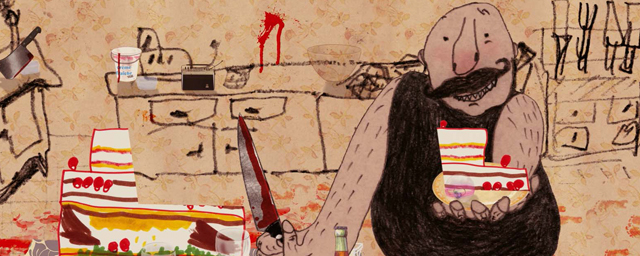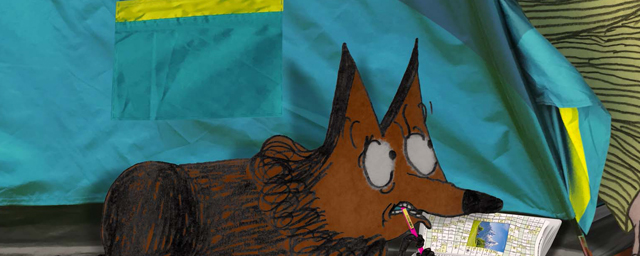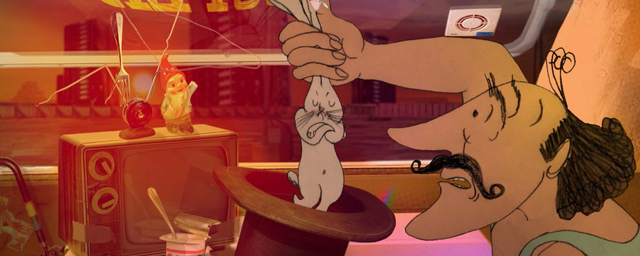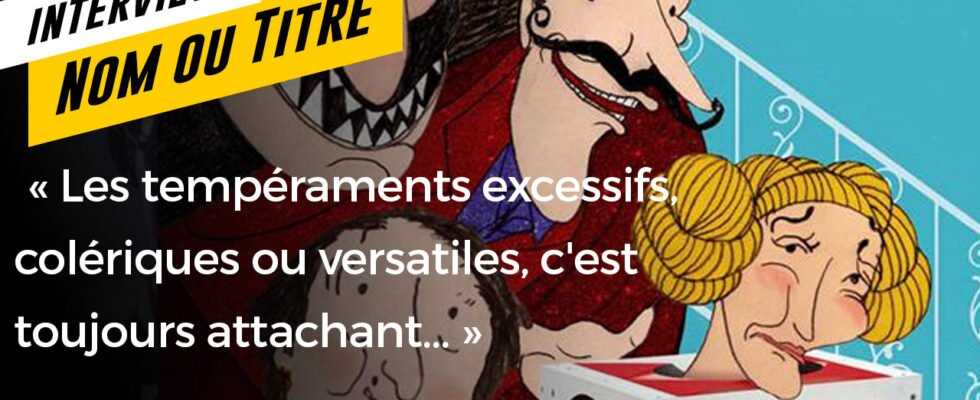This week at the cinema, Anne-Laure Daffis and Léo Marchand invite us into a building where ten colorful characters meet and uncross. Meeting around their animated film “The neighbors of my neighbors are my neighbors”.
The neighbors of my neighbors are my neighbors by Anne-Laure Daffis & Léo Marchand
Released in cinemas on February 2
An ogre breaks his teeth on the eve of Saint-Festin, the great festival of ogres. A magician misses his turn of the woman cut in two and misplaces the legs of his assistant. An over-equipped hiker is stuck in an elevator for several days. An old gentleman falls in love with a pair of runaway legs. A mother entrusts her children to the neighbor on the evening of Saint-Festin… In a building, the intertwined destinies of ten real neighbors or neighbors of neighbors, grappling with the dramas, the pleasures, the surprises and the hazards of life daily.
AlloCiné: How did the film and the different characters behind it come about? Have you linked existing short films (in particular “La Vie sans truc” and “La Saint Festin”) or, on the contrary, extrapolated stories from pre-existing characters?
Léo Marchand (director): Through the work of several years. First there was La Saint Festin in 2007, then thanks to this film, the development of a feature film, the ancestor of Neighbors of my neighbors are my neighbors, where the ogre was still present in a building with several mixed stories of the different inhabitants. The stories were not those of Neighbors… but in essence they were already there. This project never saw the light of day, but in the hollow of its script, we wrote and directed La Vie sans truc (2013). Then we made other short films. It wasn’t until almost ten years later that we took it all back to write Neighbors….

Day2Holidays
Your different characters each have their quirks, but always remain friendly and endearing. How did you manage this balance?
We don’t ask ourselves the question in balance management, we write them according to the situations they live in: like everyone else, they do things more or less out of habit and according to their personality and then something happens to them, they reflect, ask themselves questions, try to reason with each other, to find solutions, then the natural returns at a gallop, so they change their minds or suddenly get angry or make decisions that they could not have been able to plan to take a few days earlier. Flaws, weaknesses, excessive temperaments, angry or versatile, it’s always endearing, especially when they make you laugh. Which is the essence of a comedy.
Is there one that is particularly close to your heart?
No, they are a whole. You have to love them all very much to be able to animate them, except for breathing, for three years every day. This is done with the headphones of their recording on the ears permanently.

Day2Holidays
Precisely, you were able to work with a renowned voice cast: how did these actors put themselves at the service of your story? Were they able to improvise?
We are the ones who do the casting, and we are sometimes mistaken about our first choices. So we changed whenever necessary, even though the check-in was done. And once, even after starting to animate. We record all the actors separately, which allows us and them to be well concentrated on their role. In this way also, nothing is unusable by overlapping voices between actors. They only have the script sequences where their character is present, no storyboard images and we don’t give them the line. We of course ask them to say the written text, several times giving indications, but also push them to improvise on their dialogues to be able to grasp the sides they offer and which, very often, strongly characterize their character. Some improvise more than others, but we always come out of the recordings with much more material than the strict scenario.

Day2Holidays
Tell us about your visual approach, which combines several animation techniques (drawing, 3D, stop-motion, live action, TV archives, etc.)?
From our first animated short, we did that. But it really stood out with The Holy Feast. We realized that these ruptures created links and coherence in the story. When you go from one place to another, ultimately it is never neutral. The place and the way it is designed, furnished, lit, inhabited tells something good to him. All these different techniques are not there by chance but play a “character” in their own right that interacts with our drawn characters.
The film is set in a timeless France, which summons Lady Di as much as the 2007 election campaign or recent news flashes from BFMtv. What was your intention?
We are all, on more or less small scales, crossed by several eras, either directly by experience, or by cultural heritage. So we all accumulate successive strata that mix, merge, repeat themselves more or less.

Day2Holidays
At the time of the CGI-queen, is it difficult to develop such a project?
Yes and no. Yes, if at the start you don’t have a real desire and need to really make your film and you are therefore ready to water down, pervert and stifle your words by listening to the scattered and disconnected suggestions of the film, of any usual stakeholders on a project. No, if the company you set yourself from start to finish is to be the most complete, demanding and consistent with what you want to tell and what you must do.
How is animation doing in France?
The animated feature film is doing well if we consider the quantitative aspect, but if we consider the qualitative aspect, what can we say? Apart from a few films, which unfortunately can be counted on the fingers of one hand, it is difficult to see cinema there.
